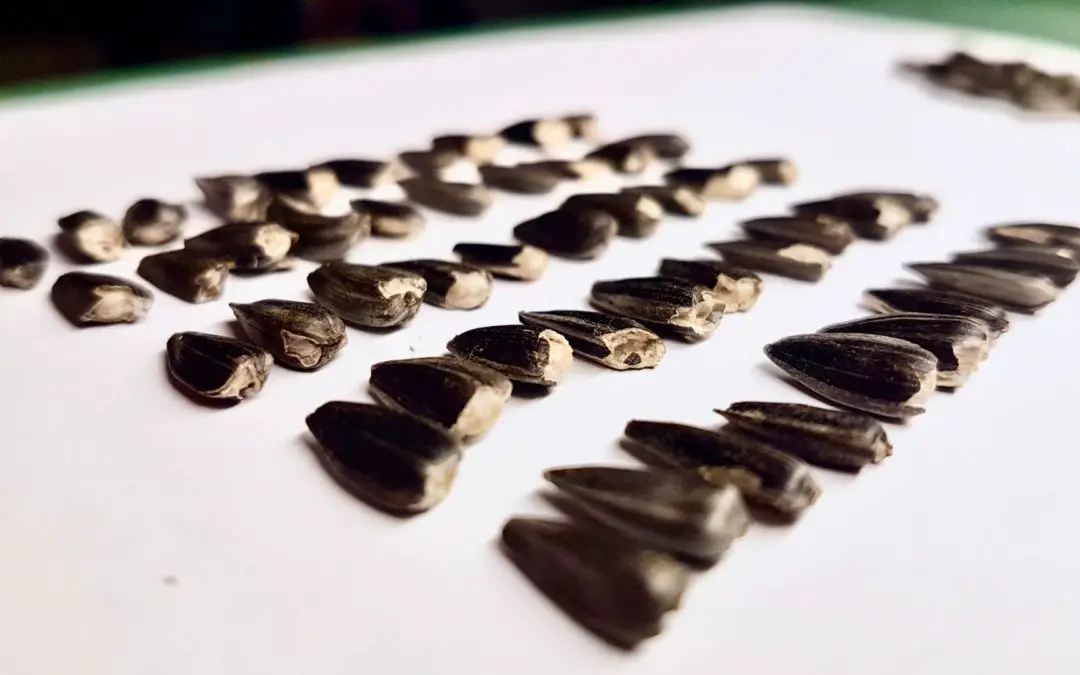You’ve probably noticed them too.
You’re measuring out your seeds for your microgreens and some of them are damaged. Are they going to grow? Or will the just soak up moisture and feed mold and other pathogens?
I was curious about this, so I ran a mini experiment.

Above are the results from the undamaged seeds. I harvested everything as close as possible to the soil line, and then lined them up from biggest to smallest.
Do damaged sunflower seeds germinate and grow into microgreens? 2.4% of my sample of sunflower seeds had chipped or damaged hulls. 88% of undamaged seeds grew to microgreen maturity. Only 20% of damaged seeds grew to harvestable maturity.

The photo above shows the seeds that had damage to their hulls. The lower germination % is definitely visible!
Experiment setup and details
For this experiment, I wanted to test undamaged sunflower seeds against damaged sunflower seeds.
I used fresh seeds (ordered about 4 months ago). More info on where I buy seeds and recommend buying seeds from in my article here.
I was curious how many seeds were actually damaged in a sample of my seeds.
So: I counted.
Slowly
There were 1252 seeds in 2.6 oz (75 grams).
There were 50 damaged seeds in 4.4 oz (125 grams) of seeds. 1252 x (4.4 oz/2.6 oz) gives us 2087 seeds in 4.4 oz. With 50 damaged seeds, that’s 2.4%. Or about 1 seed in 42 was visibly damaged.
When I do future experiments in the future I’ll check back against this 2.4% benchmark. And make sure that all the trays have the same amount of damaged seeds, or maybe I’ll just remove them altogether.
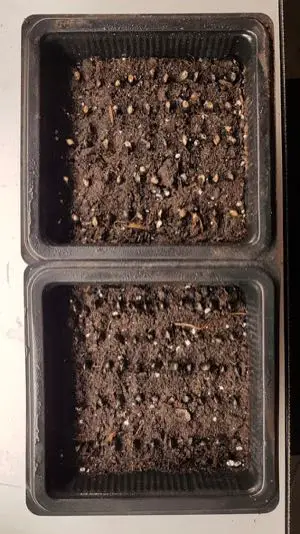 Soaking the Seeds
Soaking the Seeds
I soaked 50 healthy seeds and 50 damaged seeds separately in about 3.5 fluid ounces of fresh water each with a splash of hydrogen peroxide.
I used a coffee press to keep the seeds submerged (works great!).
When I went to plant I could only find 49 of the damaged seeds, I lost one somehow! I still had all of the healthy ones.
I planted the seeds in a grid in each tray.
I did my best to keep the seeds evenly hydrated, with a combination of watering and misting.
How the seeds failed
A lot of the damaged seeds had something in common in how they failed to grow. It was something unexpected to me!
To understand it, you have to think about how a sunflower seed germinates normally. Normally the seed soaks up water, starts growing, then splits the seed hull in half and pops it off.
But when the seed hull is damaged, something interesting happens. The sprout starts growing out of the chipped open hole. But then the root tip gets trapped in the seed hull!
This seems to be the biggest problem with mechanically damaged seeds: they don’t split open so they get trapped in the hull.
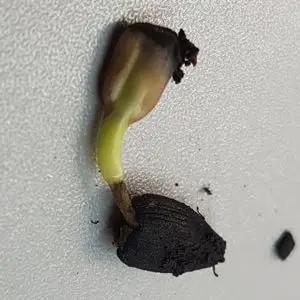
You can see an example of the root getting stuck in the seed in the photo above! It can’t absorb as much water, and doesn’t have access to soil, so the plant just dies.
Do you get Less Microgreen Yield from Damaged Sunflower Seeds?
I started out with 50 healthy (undamaged) seeds with the hulls still on. There were 6 seeds that grew slowly. Either they stayed small and had seed hulls still attached, or they sprouted roots but weren’t able to shed the hull and stalled. The other 44 germinated great. I ended up with a yield of 15 gram of microgreens.
I started out with 49 chipped (mechanically damaged) seeds with the hulls still on. 27 were stunted or growing very slowly, 10 didn’t germinate. I’d say 10 of them were big enough to be sellable (and would get kept in a normal harvest). 7 grams of microgreens were harvested.
Is it worth picking out the damaged sunflower seeds?
Picking out damaged sunflower seeds takes a lot of time. With around half of damaged seeds germinating, and the effort it takes, it’s worth the risk of mold. While the damaged seeds have good chance of decomposing, it shouldn’t be a huge problem.
Microgreens grow so quickly that they can usually out-pace micro-organisms. Especially if watering, humidity, and seeding density are dialed-in.
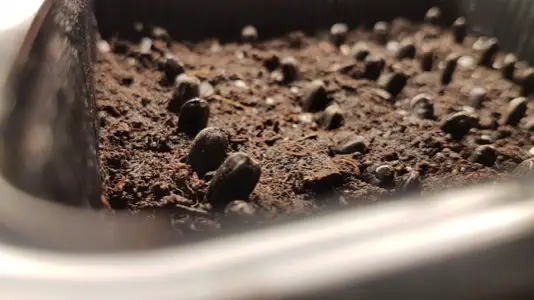
How can Sunflower seeds be damaged?
Seeds can be damaged either by handling, or during storage. Handling damage includes damage during seed harvesting, soaking, or planting. Storage damage can come from temperature, humidity, or pests.
Sunflower Seed Damage by Handling
Handling damage is the type of damage we’re dealing with in this experiment. The seed had great storage conditions, and because the healthy and damaged seeds came from the same batch, it helps us isolate to one type of damage.
These seeds were probably damaged during harvesting. A lot of sunflower seeds are harvested by combine. I’m not sure exactly how microgreens seeds are quality controlled, but I suspect there’s some extra processing to weed out some of the damaged seeds.
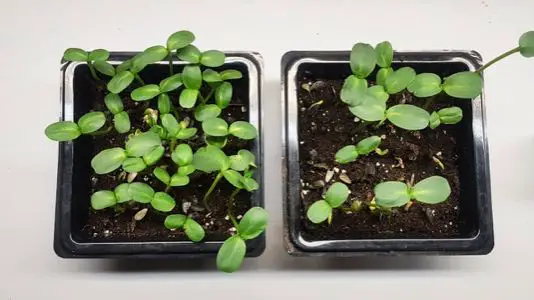
You can see the sunflower microgreens ready to harvest above. 50 undamaged sunflower seeds were planted on the left. 49 damaged sunflower seeds were planted on the right (I lost one!)
Another way microgreens can be damaged during handling is from drowning. If you soak microgreens too long, they can drown. I tested a 6 hour vs 12 hour soak in another experiment, you can read about it here.
Storage damage of microgreens seeds
Removing mold from sunflower microgreens is not fun. You can lose a section of your crop, or sometimes the whole thing!
Storage damage to seed can happen if seeds are exposed to the elements, which can happen if they’re stored on the ground. It can also happen from humidity and temperature.
If you suspect your seeds might be harbouring mold spores, make sure it’s actually mold. Telling the difference between mold and fine root hairs is a common problem with beginner sunflower microgreen growers. Find more info on telling mold apart from root hairs here.
The next section has a great link to more info on storing sunflower seeds, it’s worth a read.
How should sunflower seeds be stored?
Sunflower seeds need to be stored just like other seeds that you want to grow in the future. Store them cool, dry and dark. I put a ton of more detailed information and research into this article about microgreen seed storage.
Proper storage of seeds is definitely worth spending a few minutes reading about. It can save you a TON of headaches (dealing with mold).
Do you need special sunflower seeds to grow microgreens?
To grow sunflower microgreens, the basic idea is that you just need fresh viable seeds, like any other vegetables and herbs.
While there’s nothing particularly special about microgreens seeds in general (or sprouting seeds), they benefit from a few key things, especially for sunflowers.
- Raw
- Unsalted
- Fresh: fresher seeds germinate more evenly and quickly
- Microgreen varieties: certain sunflower seeds are bred so that their seed hull come off easier. They’re often marketed as “black oil”. I haven’t done any testing to confirm they germinate more evenly or shed hulls quicker.
Find tons more information about selecting seeds for microgreens in my article here. It could save you a lot of trouble and money!
Removing sunflower seed hulls? Solved!
Sunflowers are notorious for having seed hulls all over them when they’re ready for harvest. But there are some tips and tricks to make things A LOT easier. You can find that information in my article here.
Soaking sunflower seeds for microgreens
Soaking sunflower seeds is really important, and if you do it right, you can actually mitigate mold problems to some extent. Mold often gets a foothold on the hull of microgreen seeds first. It might be from humidity and physical contact with something that’s infected, but spores could also blow in on the wind.
The important thing is that you can do something about it.
Soaking sunflower seeds for microgreens is a critical step. Without it you have lower yields, and slower growth. By adding food-grade hydrogen peroxide to your soak water, you can increase your chances of a trouble-free harvest by a lot!
If you enjoyed this article, you might enjoy my adventures in sunflower seed soak times! I experimented with 6 hour vs 12 hour soak time and wrote up the results here.

I’m Alex Lafreniere. I learned a lot about plants when I built and operated a landscaping company. I learned even more when I started growing and selling Microgreens. But, learning is a journey, not a goal. Ever since travelling across the world, I’ve wanted to find ways to bring more delicious and exotic plants into my life. This is the site where I share everything I’ve learned with you. And maybe we’ll learn a thing or two together.
This site is owned and operated by Plant Hardware, a sole proprietor headquartered in Calgary, Canada. Plant Hardware is a participant in the Amazon Services LLC Associates Program, an affiliate advertising program designed to provide a means for sites to earn advertising fees by advertising and linking to Amazon.com. Plant Hardware may also participate in affiliate programs with Bluehost, Clickbank, CJ, ShareASale, and other sites. Plant Hardware is compensated for referring traffic and business to these companies.

